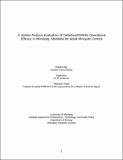| dc.contributor.author | Pawluk, Jennifer Emma | |
| dc.date.accessioned | 2022-09-08T19:37:33Z | |
| dc.date.available | 2022-09-08T19:37:33Z | |
| dc.date.issued | 2022-08-31 | |
| dc.identifier.citation | Pawluk, Jennifer Emma. A Spatial Analysis Evaluation of DeltaGard®20EW Operational Efficacy in Winnipeg, Manitoba for Adult Mosquito Control; Research Thesis prepared in partial fulfilment of the requirements for a Master of Science degree..., Department of Bioscience, Technology, and Public Policy, Department of Biology..., University of Winnipeg. Winnipeg, Manitoba, Canada: University of Winnipeg, 2022. DOI: 10.36939/ir.202209081431. | en_US |
| dc.identifier.uri | https://hdl.handle.net/10680/2017 | |
| dc.description.abstract | Background: Mosquito abatement includes the management and surveillance of nuisance and potential vector mosquitoes. The major nuisance mosquito in Winnipeg, Manitoba is Ae. vexans, a floodwater mosquito. The City of Winnipeg Insect Control Branch uses surveillance, source elimination, larvicide, and adulticide in their mosquito abatement program. Adulticide application is the last resort when the other methods are not sufficient. This study tested DeltaGard®20EW adulticide efficacy operationally on wild mosquitoes in Winnipeg, Manitoba as a replacement for the previously used Malathion 95ULV® while considering the effect of landscape features. Methods: New Jersey Light and Centre for Disease Control mosquito trap data from July 2010 and July 2020 were used to statistically detect changes in adult mosquito activity before and after treatment with Malathion 95®ULV (2010) and DeltaGard®20EW (2020). Landscape features surrounding traps that were frequently mosquito hot spots and traps that were never hot spots were compared by applying spatial analysis tools. Kriging analysis was performed to estimate changes in mosquito activity citywide. Wing lengths were used as a proxy for adult mosquito body size to determine if body size is positively correlated with mosquito longevity. Results: No significant difference was detected when comparing post-spray mosquito trap counts in treated and untreated (experimental control) locations in July 2010 or July 2020. When daily changes in mosquito activity were analyzed in the treatment group, a significant decrease in mosquito activity was detected in the group treated with Malathion 95ULV® the day after treatment with the effect lasting for two days. No significant daily changes in mosquito activity were detected after DeltaGard®20EW application. There were no significant differences between mosquito activity hot spot locations and non-hot spot locations when tree density, proximity to rivers, proximity to parks/open spaces, or parks/opem spaces density were analyzed spatially. However, hot spots were found to have more trees in a 50m radius and to be closer to rivers. A significant positive correlation between longevity and adult mosquito body size (Ae. vexans) was detected. Conclusions: The lack of significance when comparing traps in areas treated with DeltaGard®20EW and untreated areas indicates that changes may be due to natural background fluctuations in mosquito activity and population. Significant daily decreases in mosquito activity in the treatment groups were detected the day following Malathion 95ULV® treatment. The lack of significance in the DeltaGard®20EW trials may be due to issues with modelling like a lack of untreated trap locations for comparison, a starting population that was too low to detect significant changes, a lack of specific knowledge about the cumulative egg bank and Ae. vexans biology, too few trap locations, traps being placed strategically instead of randomly, the challenge of measuring background mosquito activity and population dynamics, and a lack of meteorological and landscape data specific to trap locations. Measuring adulticide efficacy in wild mosquitoes and creating models to analyze changes in their activity is challenging. A significant positive correlation between longevity and adult mosquito body size was detected for Ae. vexans mosquitoes, although further research should track specific cohorts of mosquitoes over time. | en_US |
| dc.description.sponsorship | City of Winnipeg, University of Winnipeg | en_US |
| dc.language.iso | en | en_US |
| dc.publisher | University of Winnipeg | en_US |
| dc.rights | info:eu-repo/semantics/openAccess | en_US |
| dc.subject | Mosquitos -- Manitoba | en_US |
| dc.subject | Insecticides | en_US |
| dc.subject | DeltaGard 20EW (insecticide) -- efficacy | en_US |
| dc.subject | Deltamethrin | en_US |
| dc.title | A Spatial Analysis Evaluation of DeltaGard®20EW Operational Efficacy in Winnipeg, Manitoba for Adult Mosquito Control | en_US |
| dc.type | Thesis | en_US |
| dc.description.degree | Master of Science in Bioscience, Technology, and Public Policy | en_US |
| dc.publisher.grantor | University of Winnipeg | en_US |
| dc.identifier.doi | 10.36939/ir.202209081431 | en_US |
| thesis.degree.discipline | Biology | |
| thesis.degree.level | masters | |
| thesis.degree.name | Master of Science in Bioscience, Technology, and Public Policy | |
| thesis.degree.grantor | University of Winnipeg | |

